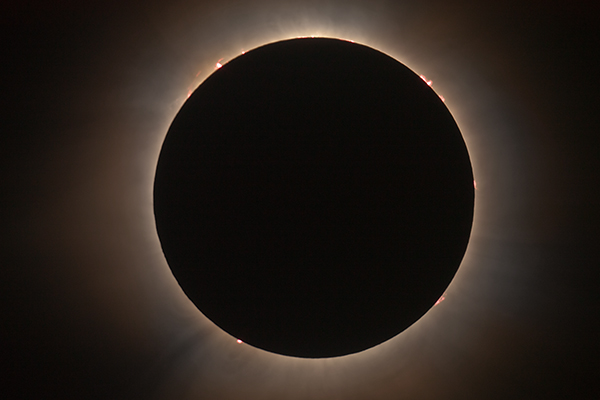For most of Canada and the USA, the April 8 total solar eclipse was a partial event with most of the sun being covered by the moon. However, for those who drove to the specific 200-kilometre-wide path of totality stretching from Texas to Newfoundland, the show was spectacular. I have seen partial solar eclipses including an annular in the past but this was my first total.
Gathering with family and friends at a Quebec cottage, we had a ring-side seat to this once-in-a-lifetime experience. The sky was blue and clouds to the south presented little concern. Solar-filtered telescopes allowed us to see the crater-covered lunar limb inch across the sun’s surface while filtered cameras clicked away and others dawning their eclipse glasses followed the progress. Temperatures had noticeably dropped as the sky was moving to a darker shade of blue while the excitement built. We gasped as the last sliver of sunlight was erased away – totality had begun.
Like turning off a light switch we were bathed in instant twilight. There was now a dark hole in the sky with a blue-white ring surrounding it. Neon pink solar prominences came into view along with the faint wisp of the solar corona. To the lower right, the brilliant planet Venus popped into view along with fainter Jupiter to the upper left. The three minutes and twenty seconds of totality passed far too quickly and the light switch turned back on. It was an emotional day I will never forget. The next total solar eclipse will occur on August 2, 2027, tracking from Morocco to Somalia lasting more than six minutes.
But this was not the last time the sun would be in the news. Our daytime star is ramping up its current cycle of activity as solar maximum is expected to peak in July 2025. At the beginning of May, a series of sunspots became visible on the limb of the sun as they normally do. Over the next few weeks, sunspot AR3664 would grow into a monster. The area spanning sixteen earths across, unleashed multiple solar flares of the serious variety. In one day no less than six Coronal Mass Ejections (CME) were heading toward Earth and the warning was issued by Spaceweather that a severe geomagnetic category 5 storm for May 10. A G5 storm is the highest on the scale with the possibility of power grid problems resulting from these solar blasts. It has been 20 years since a severe warning was issued.
The Friday night display of the Northern Lights was one of the most intense I have seen in quite a while. Palettes of bright green and red lit the ground as they shimmered in all directions including south. The overhead corona was spectacular as well. We did battle passing clouds but the overall collision of solar particles with our magnetic region around the poles played out in all its glory. There were reports of the aurora being witnessed in Florida and Puerto Rico which is rare .
If this is an indication of how the sky will entertain us this summer, I cannot wait for the next event. There might be future storms, depending on solar activity. Keep checking the Spaceweather link on my website for the ongoings of our sun.
Clear skies,
Known as “The Backyard Astronomer”, Gary Boyle is an astronomy educator, guest speaker, former monthly columnist for the Royal Astronomical Society of Canada as well as a STEM educator. He has been interviewed on more than 60 Canadian radio stations as well as various television stations across Canada and the U.S. In recognition of his public outreach in astronomy, the International Astronomical Union has honoured him with the naming of Asteroid (22406) Garyboyle. Follow him on Facebook and his website: www.wondersofastronomy.com
- Amazing Sky Shows - May 23, 2024
- The Total Solar Eclipse - March 7, 2024
- The Geminid Meteor Shower - December 12, 2023
 Wawa-news.com You can't hear the 'big picture'!
Wawa-news.com You can't hear the 'big picture'!



